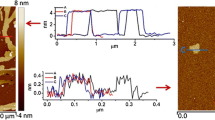Abstract
The nanoscale structural changes of crystalline cellulose by mechanical milling was studied by high-resolution microscopy (AFM, SEM, TEM). We examined influence of environment [dry, water, silicone oil (PDMS)] on cellulose milling, finding their characteristic effects on microscopic morphology of the products. Dry milling of cellulose gave aggregated globular particles with fast decrystallization. Milling with water or PDMS caused partial dispersion of nanofibers. Milling with PDMS formed micro-platelets <1 µm thick with slight decrystallization. Remarkably, nanoscale particles isolated from PDMS-milled cellulose by sonication in ethanol contained cellulose nanosheets, typically 0.1–10 µm wide and 4.2 nm thick, apparently formed by monolayer association of elementary fibrils. TEM and electron diffraction revealed crystalline nature of nanosheets, with specific orientation of (110) plane or (200) plane perpendicular to the sheet plane. A possible mechanism of the nanosheets formation is proposed, in which the elementary fibrils are aligned parallel by mechanical impacts.












Similar content being viewed by others
References
Agarwal UP, Reiner RS, Ralph SA (2010) Cellulose I crystallinity determination using FT–Raman spectroscopy: univariate and multivariate methods. Cellulose 17:721–733
Ago M, Endo T, Okajima K (2007) Effect of solvent on morphological and structural change of cellulose under ball-milling. Polym J 39:435–441
Alqus R, Eichhorn SJ, Bryce RA (2015) Molecular dynamics of cellulose amphiphilicity at the graphene–water interface. Biomacromolecules 16:1771–1783
Araki J, Kuga S (2001) Effect of trace electrolyte on liquid crystal type of cellulose microcrystals. Langmuir 17:4493–4496
Biermann O, Hädicke E, Koltzenburg S, Müller-Plathe F (2001) Hydrophilicity and lipophilicity of cellulose crystal surfaces. Angew Chem Int Ed 40:3822–3825
Bu L, Himmel ME, Crowley MF (2015) The molecular origins of twist in cellulose I-beta. Carbohydr Polym 125:146–152
Conley K, Godbout L, Whitehead MA, van de Ven TGM (2016) Origin of the twist of cellulosic materials. Carbohydr Polym 135:285–299
Ding SY, Himmel ME (2006) The maize primary cell wall microfibril: a new model derived from direct visualization. J Agric Food Chem 54:597–606
Elazzouzi-Hafraoui S, Nishiyama Y, Putaux J-L, Heux L, Dubreuil F, Rochas C (2008) The shape and size distribution of crystalline nanoparticles prepared by acid hydrolysis of native cellulose. Biomacromolecules 9:57–65
Fengel D (1971) Ideas on the ultrastructural organization of the cell wall components. J Polym Sci Polym Symp 36:383–392
Filonova L, Kallas AM, Greffe L, Johansson G, Teeri TT, Daniel G (2007) Analysis of the surfaces of wood tissues and pulp fibers using carbohydrate-binding modules specific for crystalline cellulose and mannan. Biomacromolecules 8:91–97
Fink H-P, Weigel P, Purz HJ, Ganster J (2001) Structure formation of regenerated cellulose materials from NMMO-solutions. Prog Polym Sci 26:1473–1524
French AD (2014) Idealized powder diffraction patterns for cellulose polymorphs. Cellulose 21:885–896
Gilkes NR, Kilburn DG, Miller RC, Warren RAJ, Sugiyama J, Chanzy H, Henrissat B (1993) Visualization of the adsorption of a bacterial endo-β-1, 4-glucanase and its isolated cellulose-binding domain to crystalline cellulose. Int J Biol Macromol 15:347–351
Habibi Y, Lucia LA, Rojas OJ (2010) Cellulose nanocrystals: chemistry, self-assembly, and applications. Chem Rev 110:3479–3500
Hadden JA, French AD, Woods RJ (2014) Effect of microfibril twisting on theoretical powder diffraction patterns of cellulose Iβ. Cellulose 21:879–884
Helbert W, Nishiyama Y, Okano T, Sugiyama J (1998) Molecular Imaging of Halocynthia papillosaCellulose. J Struct Biol 124:42–50
Igarashi K, Koivula A, Wada M, Kimura S, Penttilä M, Samejima M (2009) High speed atomic force microscopy visualizes processive movement of Trichoderma reesei cellobiohydrolase I on crystalline cellulose. J Biol Chem 284:36186–36190
Kimura S, Itoh T (2004) Cellulose synthesizing terminal complexes in the ascidians. Cellulose 11:377–383
Klemm D, Heublein B, Fink HP, Bohn A (2005) Cellulose: fascinating biopolymer and sustainable raw material. Angew Chem Int Ed 44:3358–3393
Lehtiö J, Sugiyama J, Gustavsson M, Fransson L, Linder M, Teeri TT (2003) The binding specificity and affinity determinants of family 1 and family 3 cellulose binding modules. Proc Natl Acad Sci USA 100:484–489
Moon RJ, Martini A, Nairn J, Simonsen J, Youngblood J (2011) Cellulose nanomaterials review: structure, properties and nanocomposites. Chem Soc Rev 40:3941–3994
Nishiyama Y, Johnson GP, French AD, Forsyth VT, Langan P (2008) Neutron crystallography, molecular dynamics, and quantum mechanics studies of the nature of hydrogen bonding in cellulose Iβ. Biomacromolecules 9:3133–3140
Nishiyama Y, Johnson GP, French AD (2012) Diffraction from nonperiodic models of cellulose crystals. Cellulose 19:319–336
O’Sullivan AC (1997) Cellulose: the structure slowly unravels. Cellulose 4:173–207
Paes SS, Sun S, MacNaughtan W, Ibbett R, Ganster J, Foster TJ, Mitchell JR (2010) The glass transition and crystallization of ball milled cellulose. Cellulose 17:693–709
Rao X, Kuga S, Wu M, Huang Y (2015) Influence of solvent polarity on surface-fluorination of cellulose nanofiber by ball milling. Cellulose 22:2341–2348
Segal LC, Creely J, Martin AEJ, Conrad CM (1959) An empirical method for estimating the degree of crystallinity of native cellulose using the X-ray diffractometer. Text Res J 29:786–794
Staudinger H, Döhle W (1943) Über Inklusionscellulosen. 310. Mitteilung über makromolekulare Verbindungen. J Prakt Chem 161:219–240
Sun P, Kuga S, Wu M, Huang Y (2014) Exfoliation of graphite by dry ball milling with cellulose. Cellulose 21:2469–2478
Woodcock C, Sarko A (1980) Packing analysis of carbohydrates and polysaccharides. 11. Molecular and crystal structure of native ramie cellulose. Macromolecules 13:1183–1187
Zhang L, Tsuzuki T, Wang X (2015) Preparation of cellulose nanofiber from softwood pulp by ball milling. Cellulose 22:1729–1741
Acknowledgments
This study was supported by the National Natural Science Foundation of China (Nos. 51373191, 51172247, 51472253) and the Chinese Academy of Sciences Visiting Professorships.
Author information
Authors and Affiliations
Corresponding authors
Electronic supplementary material
Below is the link to the electronic supplementary material.
Rights and permissions
About this article
Cite this article
Zhao, M., Kuga, S., Jiang, S. et al. Cellulose nanosheets induced by mechanical impacts under hydrophobic environment. Cellulose 23, 2809–2818 (2016). https://doi.org/10.1007/s10570-016-1033-8
Received:
Accepted:
Published:
Issue Date:
DOI: https://doi.org/10.1007/s10570-016-1033-8




